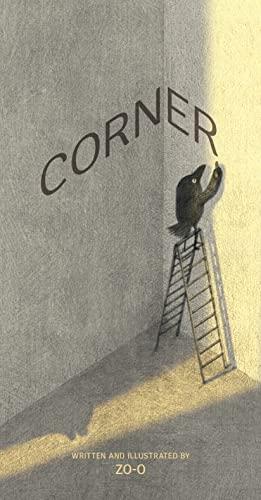Corner

Corner
In her first picture book translated into English, South Korean author/illustrator Zo-O (whose pseudonym translates as “Crow Zoo”) creates a nearly wordless parable about loneliness and boredom. As the book begins, a small black crow stands alone in the corner of a colourless room. The floor is grey, and the walls are white. Apart from the crow, the room is empty. Looking for diversion, the crow first experiments with different ways to sit, initially crouching upright in the corner and next lying on the floor with feet splayed on the walls. However, the crow is soon restless and looking for new ways to entertain herself. (There are no clues to the gender of the crow, but I have chosen to refer to the bird as “she” since the author/illustrator has given herself the name of “Crow”).
First the crow drags in a bed and soon adds more furniture to the empty room: a circular blue rug, a bookcase, a stack of colourful books, a table lamp, and a small green plant. Lying on the rug, the crow speaks hopefully to the only other living thing in the room, the plant, addressing it with a friendly, “Hello?”, but, of course, the plant remains silent, and the crow remains alone (and presumably lonely). In subsequent pages, the crow is seen spending her days reading the books, watering the plant, napping on the bed, and eating a bowl of food. Time is clearly passing as the plant is growing larger and larger. However, the crow is still not fully satisfied with the comfortable environment she has made for herself and poses the question, “Hmmm, what else?” Something is still missing.
Soon the crow has an idea; seizing a yellow crayon, she starts to make geometric patterns on the wall. When she has covered as much wall space as she can reach, she carries in a ladder, and her designs soon extend higher and higher up the wall. She brings in a speaker and plays music while drawing. It’s obvious from the crow’s energetic activity that she is now fully absorbed in creativity and time is passing much more quickly. At one point, the crow, stopping to notice that the once minuscule plant is now towering over her head, exclaims, “You’re getting so big!” When the walls are filled with yellow patterns, the crow stops to consider her room and observes that “Something is still missing.” What could it be?
Suddenly, the crow knows the answer; using a circular saw, she cuts a window in the wall. It lets in light and gives her a view into the outside world. Opening the window, she sees another bird who responds to her “Hello?” with a friendly “Hi.” The crow has a friend.
The soft coloured pencil illustrations in Corner are subtly textured, and the crow’s gestures make the story easy to follow despite the almost complete lack of words. Children can easily relate to the crow, and the story encourages all of us to think about what we would do with free time in an empty room: what would we need to feel whole and happy? Zo-O suggests that satisfying the need for food and shelter is not enough; like the crow, we need creativity, and we need companionship to feel contented.
Dr. Vivian Howard is a professor in the School of Information Management at Dalhousie University in Halifax, Nova Scotia.
